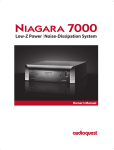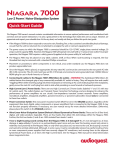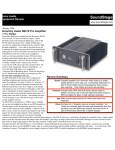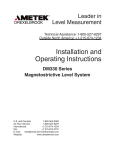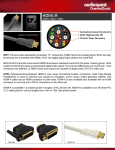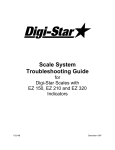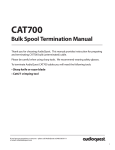Download Operation and Trouble-shooting Primer
Transcript
Operation and Continuous Use Power Switch/Circuit Breaker and LED Power Indicator Once the AC cords are properly connected to the AC source tap, and the components are connected to the appropriate outlet banks, it is safe to energize the Niagara 7000. On the right-hand side of the Niagara 7000’s front panel, there is a black rocker switch. Firmly press the rocker switch so that its upper portion is flush with the front panel. Typically within a couple of seconds, you should hear an audible “clack” sound(s) from one or more relays within the Niagara 7000. At the same time, the front-panel LED power indictor will glow blue, signifying that the unit is operational. (If this does not occur, see the “Trouble-Shooting Guide” in this manual.) Rear-Panel Power Correction Switch/Niagara 7000 Current Draw The default position for this switch should always be “Engaged”—even for applications in which there are no power amplifiers of any kind powered by the Niagara 7000. Defaulting to “Engaged” serves two functions: It activates the Transient Power Correction Circuit for power amplifiers that would be energized by outlet banks 1 or 2, and also provides a portion of the Ultra-Linear Noise-Dissipation Circuit for outlet banks 3 through 6. Although no damage to the Niagara or the connected components will occur, performance will be noticeably compromised when this switch is not set to the “Engaged” position. However, there is one exception to this. Niagara 7000 has an internal current sense circuit that will automatically engage the Transient Power Correction Circuit, as well as turn it off when your audio/video system is placed in standby mode. To utilize this feature, two things must be present: 1.The primary power amplifier(s) or powered receiver must be connected to High Current/Low-Z Power Correction Bank 1 only (as it is the only power bank with the current sense monitoring for this circuit function). 2.The primary power amplifier(s) or powered receiver must have a power standby mode, and its current consumption at 120VAC in standby mode must not exceed 25 watts. (Although 1 watt is an industry standard for standby power, many great amplifiers routinely dismiss it for reasons of performance over power savings. Therefore, you should consult the specification sheet in your amplifier’s user manual.) If these two requirements cannot be met, simply place the power correction circuit switch in the “Engaged” position and leave it there! Rest easy, knowing that you will receive every last bit of performance the circuit can deliver. However, if your system allows for the scenario listed above and your amplifier(s) or powered receiver meets the criteria listed above, you may wish to take advantage of the standby circuit. (It is likely that many systems will meet these criteria. However, if the standby function is not important to you, simply leave the switch in the “Engaged” position). The standby function was not created to place the connected system into a standby or switched mode, but rather to place the Transient Power Correction Circuit into standby mode (disengaged), for instances when the system is powered but not functioning (i.e., when there is no signal present). This was implemented because the Transient Power Correction Circuit creates a reactive current draw of as much as 9 to 10 amps RMS at idle (real world draw is a small fraction of an amp), and electrical technicians who connect a current probe to a product such as this are frequently alarmed: They suspect that the product is either broken or that it is drawing a distressingly high amount of current from the wall outlet (akin to a pair of monoblock power amplifiers left in full operational mode). This is actually far from the truth. If the Niagara 7000 was consuming that much current (or even 20% of that level), it would need to dissipate the energy loss in heat. It would be quite warm (even hot) to the touch, just like most power amplifiers while in operation. In fact, the Niagara 7000 runs cool, precisely because this current reading is false. The circuit utilizes massive capacitive reactance across the AC line, which, akin to a battery, will both absorb and immediately release the current several times per second. Further, when incorporated with power supplies such as those found in power amplifiers, the current readings actually come down! This is due to what’s known as a vector load, and it’s quite dynamic in an audio system. In this scenario, there is one thing that can run somewhat warmer than it might otherwise: the AC cord that supplies power to the Niagara 7000. This is because the wiring and the circuit breaker that supply power to Niagara 7000 simply look at RMS current and do not distinguish between reactive loads, resistive loads, or inductive loads, but your utility does. This circuit and many like it have been utilized for many years, and, when tested into buildings with absolutely no loads present aside from the transient power correction circuit, there was virtually zero power draw from the utilities power meter. Still, in an age where so-called “smart meters” are omnipresent, and some utilities may or may not change their standards for “what type of power or current is suitable for billing,” we have gone to great lengths to offer an alternative to those who may be concerned, but who nevertheless wish to achieve the best possible audio or video performance. Again, if you wish to utilize this feature, and your amplifier(s) and/or powered receiver meet the criteria, simply place the Power Correction Switch in the “Standby” position. Otherwise, please leave the switch in the “Engaged” position. Ground Fault Circuit Interrupter (GFCI) “Test” Button/Momentary Switch To offer unparalleled safety and security for both you and your valuable equipment, the Niagara 7000 features a ground fault interruption circuit for the Ultra-Linear Noise-Dissipation Dielectric-Biased Symmetrical Power outlets. This will trip the front-panel power switch (which also acts as an ultra-low resistance 20-amp RMS magnetic circuit breaker) if there is ever more than 5.5mA of current leakage from Line to Ground or Neutral to Ground. This is extremely rare, and only exists as these four outlet banks utilize two isolation transformers as part of their circuitry. Since the output is Symmetrical (Balanced), there is voltage potential on Neutral relative to Ground. In and of itself, this is not at all a problem or danger; in fact, it is precisely the feature used by the transformer in most components with a linear power supply (in that application, called “center tapped”). However, if a connected component’s power supply were to suffer a catastrophic failure, there would be a remote possibility of some AC voltage being present on the component chassis. With the incorporation of the GFCI, this is not possible, as the current fault would shut off the main power switch within a tiny fraction of a second. Because we insisted on creating it for optimal performance and safety, this method of redundancy protection is complex and costly. As a result, the symmetrical outlet banks in the Niagara 7000 are safer to use than those found in any home, office, or hospital. To ensure the circuit is functioning properly, simply lightly press the button. (It is a momentary switch, so it will not latch.) This should instantly disengage the front panel’s power switch/circuit breaker, and the blue power indicator will no longer light. Once this “test” has been performed, you will not need to do so again unless the unit is moved or has been serviced. Extreme Voltage Indicator One portion of the Niagara 7000’s non-sacrificial surge protection is dedicated to a fast-acting extreme voltage shutdown circuit. If more than 140VAC is present on the incoming AC line for more than a quarter of a second, the circuit will instantly open a high-current relay that will disengage the AC power from all of the Niagara 7000’s AC outlets, activating the red front-panel LED “Extreme Voltage” warning indicator. Once the event has passed, or the building wiring fault has been corrected, the circuit will automatically re-engage. XFMR-1 and XFMR-2: Front-Panel Circuit Breaker Reset Buttons If either AC outlet banks 5 and 6 (XFMR-1) or banks 3 and 4 (XFMR-2) exceed 5 amps RMS capacity, the circuit breaker will trip, the output to those AC outlet banks will no longer be present, and the breaker will need to be reset. (The tip of a pencil or pen will work well for resetting the breaker.) If you are uncertain about the current that your connected products will draw at 120VAC input, consult your user manuals. Note: We are referring to 5 amps per isolated dielectric-biased symmetrical power group; this will have no effect on power amplifiers that can draw far in excess of 5 amps! Most line-level audio products will draw far less than one amp—typically, a fraction of an amp. Most projectors and flat-screen televisions are also well under 5 amps, though there are exceptions. Most plasma televisions are also under 5 amps, and, contrary to myth, are not current-starved devices; they utilize voltage amplifiers with constant current draw. The Dielectric-Biased Symmetrical Power outlets are the appropriate AC outlets for these devices. It is quite unlikely that you would ever need to reset these, and far less likely that you would need to reset both. Break-in Time/Continuous Use The Niagara 7000 is made of a variety of passive and active components. Though every attempt has been made to reduce the necessity of so-called “break-in,” “burn-in,” or “run-in” time—including high-power run-in of every critical capacitor in the Ultra-Linear Noise-Dissipation Circuits—the Niagara 7000 will benefit from continuous use, just like any other audio/video component. This is not to say that you will be made to “suffer” through weeks or months of intolerable performance until that “magic day” when the parts are fully formed and ready. On the contrary, the Niagara 7000 will perform very well from the first moment you use it. It will improve gradually, in small increments, over a period of approximately two weeks. While leaving the Niagara 7000 turned on during this period will aid the process, it is also perfectly acceptable to turn the unit off; doing so will simply increase the time it takes to reach final “break-in.” The Niagara 7000 has a five-year warranty, but it was designed to last for over two decades. Provided that the Niagara 7000 is used inside a home, store, studio, or office with a reasonable climate (45 degrees to 100 degrees Fahrenheit, with less than 20% humidity), it can be left on continuously; there are no parts that will wear out. Specifications Surge Suppression: Non-sacrificial (nothing to damage with repeated 6000V/3000A input surge tests, which is the maximum that can survive through a building’s AC electrical panel). Extreme Voltage Shutdown Voltage: 140VAC (will activate the main high-current relay to open within less than 0.25 second; automatically resets once the incoming power is within a safe range). Common-Mode Noise Dissipation: In excess of 30dB from 60Hz to 100MHz, linearized for dynamic (rising) line impedance with frequency (source) and 10 to 50 ohm load, system current dependent. Transverse-Mode Noise Dissipation: In excess of 24dB from 3kHz to 1GHz, linearized for dynamic (rising) line impedance with frequency (source) and 10 to 50 ohm load, system current dependent. Input Current Maximum Capacity: 20 amps RMS (total). Ultra-Linear Dielectric-Biased Symmetrical Power AC Outlet Banks: 4 (two 100% isolated groups total). Group one is AC Bank 5/6 and group two is Bank 3/4 (5 amps RMS total per group, maximum output current capacity). Number of AC Outlets: 12 (4 High Current/Transient Power Correction; 8 Ultra-Linear/ Dielectric-Biased Symmetrical Power). Power Consumption: Typically, less than 0.25 amps at 120VAC input, or with the power correction switched to Standby setting. (This is dependent on a reactive vector load. For more info, see “Operation and Continuous Use: Rear-Panel Power Correction Switch – Niagara 7000 current draw.”) Dimensions: 17.5” W x 5.24” H x 17.2” D (3-RU rack-mounting ears, optional) Weight: 81 lbs. Trouble-Shooting Guide At AudioQuest, we always appreciate hearing from you. However, if you have questions, problems, or suspect that your Niagara 7000 requires service, please start here. There is no power to any of the AC outlets. When the Niagara 7000’s front-panel LED power indicator glows blue, the unit is operational. If the Power On indicator is not lit, consider the following: Is the upper portion of the front-panel rocker switch fully flush with the chassis? Is the input AC cord fully inserted into the Niagara 7000’s AC inlet? Is the input AC cord properly plugged into the wall AC service outlet? Is the wall’s AC outlet functioning properly? Plug into the outlet another component, product, or lamp to verify that power is present and that the electrical panel’s circuit breaker has not tripped. If there are only one or two AC outlets that have no output power, a component may be malfunctioning. Verify the AC output with a known simple device such as a lamp. There is no power to any of the AC outlets and the red front-panel Extreme Voltage indicator is lit. This indicates that either there is more than 140VAC (+/-3V) present on the wall’s AC service outlet, or the Niagara 7000’s protection circuit is miscalibrated. The latter is quite rare. (This circuit is adjustable, but it’s tested and retested before it leaves the factory, and it’s glued into place, so shipping will not affect it.) Use an AC voltage meter to determine if your outlet has too much voltage to be safe for operation, or if there is a wiring fault that is causing this to occur. Once the power is brought into a safe range for operation (90VAC to 137 VAC), the Niagara 7000’s protection circuit will automatically switch to operational mode and the blue power indicator will light. There is no power to any of the “Ultra-Linear Dielectric-Biased Symmetrical Power” outlets. The front panel has two 5-amp circuit breaker reset buttons that are slightly inset from the edge of the panel. The button to the left controls AC outlet banks 5 and 6, and the button to the right controls AC outlet banks 3 and 4. It would be VERY unlikely that both circuit breakers would trip from too much RMS current draw per outlet group. However, if one outlet group (banks 3 and 4) or the other group (banks 5 and 6) has no output, check to see if the breaker for that AC outlet group has tripped. To reset the breaker: Using the back of a pencil or pen, press the appropriate circuit breaker reset button into the chassis until it reaches its normal state—slightly loose, with little spring tension. When resetting or testing the reset of one or both of the front-panel 5-amp XFMR-1 and XFMR-2 circuit breakers, it is important that the AC outlet group is not connected to a component or product that is defective and has shorted. To verify that the circuits are working, we recommend disconnecting all but one known properly functioning product from the AC outlet group. If after verifying that the circuits are operating (or, if after resetting the circuit breaker for one of the power groups), you discover that one or multiple products activate the circuit breaker, check the current consumption rating of that/those products. (Typically, this information can be found on the last page of the component’s owner’s manual; it should be listed as the power consumption at 120VAC.) The current specification will typically be in watts. Know that 5 amps at 120VAC equals 600 watts. (You will want to be at least slightly under that number.) You may simply add wattage ratings to calculate your total consumption: If you have four components into group one (banks 5 and 6), the maximum capacity of all four outlets combined is just under 600 watts or 5 amps. The same is true for group two (banks 3 and 4). The main power rocker switch/circuit breaker tripped to the lower (off) position while the system was playing. You may have exceeded the maximum current capacity of the Niagara 7000. This should be rare, but it may be possible. Typical power amplifiers draw about one-third of their maximum current consumption at 120VAC, as listed in the product’s specifications (typically found in their owner’s manual). This is further complicated by the fact that the power consumption to AC outlet group one (banks 5 and 6) and two (banks 3 and 4) is an additional draw on the maximum current capacity of 20 amps that will trip this switch/magnetic circuit breaker. The Transient Power Correction Circuit may also contribute to the overall draw seen by the circuit breaker. Still, it should be rare that the total capacity is exceeded, but, given that some televisions, projectors, and power amplifiers can draw substantial current, it is certainly not impossible. If this is the case, an additional Niagara 7000 or Niagara 5000, and a discrete 15- to 20-amp AC service on the same phase of the electrical panel, will be required for some or all of the power amplifiers. When a component was plugged into one of the Ultra-Linear Dielectric-Biased Symmetrical Power outlets and switched on, the main power rocker switch/circuit breaker tripped to the lower (off) position. You have likely tripped the GFCI circuit (ground fault protection). This circuit ensures that even in the event of a catastrophic failure to the connected components’ power supply and/or circuits (demonstrated by full shorting and possible smoke), there will be no AC voltage on the components’ chassis that could possibly shock a person. This circuit instantly recognizes if there is more than 5mA of current leakage from Line to AC Ground, or Neutral to AC Ground. This is the maximum current allowed for ALL 8 of the Symmetrical AC outlets. If this current leakage is detected, the main power switch/magnetic circuit breaker will immediately switch off, thus protecting the system operator and all others that might come in contact with the system. It is very rare for this circuit to trip. If it does, the connected component that causes this is either defective (most likely), or it (and possibly another component on the same Symmetrical Power bank) may have a combined current leakage to ground that exceeds 5mA. Technically, this is not allowed in modern electronic circuit design, but that does not necessarily mean an otherwise well-performing product with an “unconventional” power supply is unsafe to use. Such a component may need to be used with either the Niagara 7000’s high-current AC outlets, which do not utilize the GFCI protection circuit, or they may be powered by another discrete AudioQuest Niagara Series power product, thus preventing the GFCI nuisance tripping. As a final check, inspect the GFCI test button on the left side of the Niagara 7000’s front panel. It is a momentary switch and it will not latch; by pressing it lightly into the chassis, it will activate the GFCI protection circuit and trip the main power switch/magnetic circuit breaker. Though extremely rare, it is possible that the switch could be stuck in an “on” position from taking a blow during shipping. (The rest of the unit may be perfectly fine, but the tolerance of this test button switch to the chassis and front panel is tight.) When pressed, the switch should exhibit some “travel” or “give” and should not feel binding in any way. If the switch feels tight or stuck, there may be a problem. (This will require servicing, so please be certain.) My power amplifiers sound muddy, compressed, or weak. The Transient Power Correction Circuit may not be operating. Be sure that all power amplifiers, powered receivers, powered loudspeakers, and or powered subwoofers are plugged into the High Current/Power Correction AC outlets. If any of these are plugged into the Ultra-Linear Dielectric-Biased Symmetrical Power outlets, the connected power amplifier(s) will be current compressed, as the impedance is too high for any power amplifier. If the power amplifier(s) are plugged into the High Current/Power Correction AC outlets, make certain that the rear-panel Power Correction switch is in the “Engaged” position. Although it is possible for the Power Correction Circuit to work properly while the switch is in the “Bypass” position (see “Power Correction Switch,” p.12), you might find that the unit sounds substantially better in the “Engaged” position. If this is the case, it is possible that Trouble-Shooting Guide, continued the main or primary power amplifier(s) are not plugged into High-Current AC bank 1, the power amplifier has insufficient current draw to activate the circuit, or the circuit is miscalibrated. When the Power Correction switch is set to the “Engaged” position, the current sense circuit will be defeated. Yet, even with the current sense circuit functioning properly, audiophiles may prefer the “Engaged” position, as it will slightly decrease the impedance of the Transient Power Correction Circuit. My Niagara 7000 has no power amplifiers connected to it, but it sounds odd or not quite as good as it once did. The Transient Power Correction Circuit also aids the Ultra-Linear Noise-Dissipation Circuits. Make certain that the rear-panel Power Correction switch is in the “Engaged” position. A technician or electrician found that my Niagara 7000 consumes over 8 amps of current. Is it broken? No, it’s not broken, and it’s not drawing 8+ amps in any conventional sense. The Niagara 7000’s Transient Power Correction Circuit creates a reactive current draw of as much as 9 to 10 amps RMS at idle, and, when incorporated with power supplies such as those found in power amplifiers, the current readings decrease. This is a vector load, which will vary with the connected equipment. When plugged into an AC service that has no other electrical draw, it is typical to see a real-world RMS power draw well below 30 watts at idle. (For an in-depth explanation of the circuit, see “Power Correction Switch,” p.12.) I did not notice hum with any prior power device, but there is a hum in my system with the Niagara 7000. Typically, this will not occur. In fact, the Niagara 7000’s two Ultra-Linear Dielectric-Biased Symmetrical Power outlet groups are 100% isolated from one another, 100% isolated from the High Current/Power Correction outlet group, and floating. This allows opportunities to break up ground loops in an audio system. However, the hum created by ground loops (typically, a voltage differential from Neutral to Ground among two or more signal-connected devices in an audio/video system) can at times be quite complex and difficult to easily diagnose. To diagnose the hum/ground loop: With everything else unplugged, start with the simplest system that can still play music through your loudspeakers. Use a source such as a universal player, computer, or a turntable so there is no external cable or satellite cable connected to ANY of the associated components. Is there any hum? If yes, and there is more than one line-level (non-power amplifier) component connected in this “minimalist” test, try placing one in Symmetrical Power group one and the other in group two. If the hum no longer persists under these conditions (which is likely), try reconnecting each additional component into the Niagara 7000 one at a time. Once you find the component that creates the hum, you can possibly achieve increased isolation by connecting it to a different Ultra-Linear/Symmetrical Power outlet group. This can typically help, as well as increase overall system performance by decreasing system noise. If adding a cable or satellite signal to the system reintroduces the ground-loop hum, that incoming signal line may require an isolation transformer or humbucker. If it seems that hum didn’t occur before, but does now, it’s most likely that the hum was in fact always there. The difference is simply a matter of degree. Sometimes the ground loop difference is right on the edge of breaking into an area where it’s audible, instead of only measureable with electronic measurement instruments. The very act of creating better connections, thus minimizing the impedance to the power amplifiers, can tip the scales. If the hum/ground-loop exists on the incoming satellite or cable line, then it will be necessary to fix the real problem. This is common with large custom install systems. As these signal lines are always grounded in a different place and at a different potential than the rest of the system’s ground return, the system will benefit greatly by utilizing isolation under these conditions. In rare circumstances, there are some computer peripherals or DACs that feature three-prong grounded AC cords and whose circuits rely on a hard AC ground (i.e., they cannot be floated). Under these rare circumstances, you may obtain better results with that one component plugged into one of the High Current/Power Correction outlets or into an accompanying Niagara 5000, 500, 200, or 100 Low-Z Power Noise-Dissipation System. My home or grounds were hit by lightning. The Niagara 7000 seems to be functioning properly. Should it be sent in for inspection or service? If you see or smell smoke coming from the unit, it needs service. Otherwise, if it functions after such an event (which is very likely), there is nothing that would be compromised or damaged. If it fails after such an event, it will fail totally. However, it’s unlikely that this would occur. The circuit is designed to easily handle any voltage or current surge that could possibly make it past an electrical panel. The force required to damage the Niagara 7000 via a power surge would melt the panel and burn the building (in which case, the Niagara 7000 is the least of your worries). I broke off an AC plug tab while connecting or removing one of my AC cords. The tab is stuck in the outlet. What should I do? First, turn off or place on standby/mute all of your components, then turn off the Niagara 7000. Next, only after you are absolutely certain that the power switch is off—you could also remove the input AC cord for even greater safety assurance—use a strong set of pliers or a small handheld vice grip tool to grasp the portion of the tab that is protruding from the NRG Edison outlet. While producing moderate outward pressure, gently wiggle the tab until it pulls free from the outlet. This should be all that is necessary, and the outlets should be fine. This will be a rare occurrence, but, because the gripping strength of the NRG Edison outlets is far greater than that of generic or audiophile-grade AC Edison outlets, it is possible, if: An AC cord plug has tabs that are slightly oversized or An AC cord plug has plating that is overly thick; or an AC cord plug is installed or removed in haste. How do I clean the chassis and/or the electrical contacts? The Niagara 7000’s black-painted chassis and dark chrome front panel can be cleaned with AudioQuest CleanScreen or a modest misting of household window cleaners. Please use soft cotton or wool toweling to remove the liquid from the metal and painted surface. Whenever possible, use the supplied polishing rag for the front panel, only using liquid cleaner when oil or grime is beyond the polishing cloth’s capacity to thoroughly clean. Never use alcohol or solvent-based cleaners. They can damage the surfaces, paint, and silk-screening material. The AC inlet, outlet posts, and grips are all generously plated with silver. There is no need to clean these if they are not exposed to foreign substances such as grease and dirt. Silver oxide is a superior conductor to silver itself. If cleaning is required, Isopropyl alcohol (preferably 99% purity) on a cotton swab is best for the inlet tabs. Some manufacturers provide specialized cleaners for the AC output surfaces. Again, however, cleaning these surfaces will most likely be unnecessary. Note: A pipe cleaner or cleaning swab with a wood stick and compact wool tip (available from an electronics supply house) will be superior to household swabs. When working in a small area such as an AC outlet, this is critical. Loose strands of cotton may damage the AC outlet. Damage to an AC inlet or outlet due to cleaning is not covered under your warranty. If you damage an inlet or outlet in an attempt to clean it, you will be charged for the repair and you will be responsible for all shipping costs. I hear a slight buzzing sound coming from the Niagara 7000. Is it damaged? No, it’s not damaged (or, at least, damage is very unlikely). If you’re in an extraordinarily quiet room and you hear this buzzing sound only when in relatively close proximity to the Niagara 7000, or only when you place your ear next to the unit, the buzzing is normal and, unfortunately, cannot be eliminated. Trouble-Shooting Guide, continued What you are experiencing is called magnetostriction. When an extraordinarily high quantity of harmonic distortion is present on an AC line, or when the AC line contains some DC offset voltage that should not be present, even the finest power transformers in the world will react to this problem. In order to reduce or eliminate this distortion, the power transformers try to turn it into heat, causing the transformers’ steel alloy core to hum at 60 cycles per second and all harmonics above that. This has no effect on the performance of the Niagara 7000 or its connected components. Ninety-eight percent of installations never exhibit this problem, but that’s no help to the 2% that do. The Niagara 7000 features a very robust DC-blocking circuit that feeds the input or primary to each of the AC isolation transformers, but there are times when otherwise fabulous audio/video component or computer products can nevertheless backwash DC (or a severely chopped waveform) into the output secondary of the transformers. When this occurs, it is necessary to perform some experimentation: Remove each component and its AC cord, one at a time, from the Ultra-Linear Dielectric-Biased Symmetrical Power outlet groups one or two. (The High Current/ Power Correction Outlets are in no way connected to these transformers, so these may stay as they are.) Once magnetostriction is present on a transformer core, the audible noise (saturation) becomes greater as the transformer is asked to pass more current. Moving some products, or a moderately high-current product, to the opposite transformer group may alleviate the problem. Additionally, many computer drives come with external (wall-wart type), switching power supplies that feature chopped AC waveforms. If mechanical noise is present, such power supplies may be better served by the Niagara 7000’s High Current outlets or by using an additional, smaller Niagara Series product, such as the Niagara 5000 or Niagara 500, which does not employ transformers. If you notice that the slight buzzing sound has increased over time (i.e., was once negligible, but is now quite noticeable), please understand that the Niagara 7000’s AC isolation transformers are like the proverbial “canary in a coal mine.” In all likelihood, the Niagara 7000 has not developed a problem. (If you remove all of the AC output cords and listen for the slight buzzing sounds, you will likely find that they are gone.) However, it is possible that otherwise state-of-the-art components are causing the problem. Investigate valve or vacuum tube power supplies. If the tube(s) are wearing, some circuits will offset some DC onto the AC line and back to the Niagara 7000, or affect the AC waveform that the Niagara 7000 feeds. If the components were going into a power filter or conditioner without transformers, you would never be aware of the problem, but transformers never lie: It’s time to replace one (or more) of the power supply tubes!









